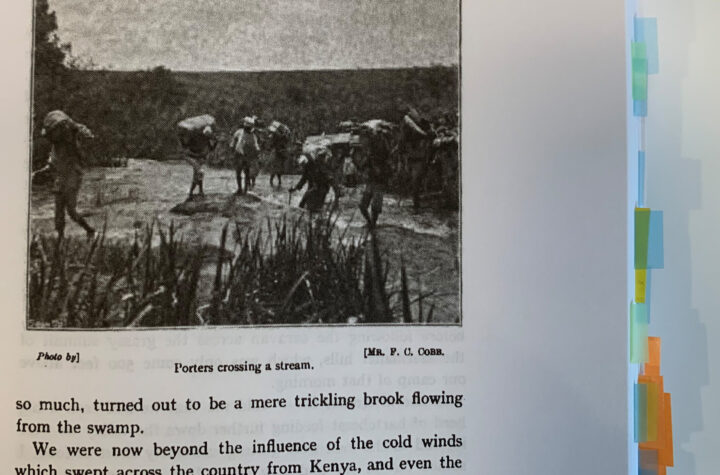
As I began my project, I wanted to know more about the narrative that the Powell-Cotton founder and patriarch, Major Percy Horace Gordon Powell-Cotton had put out into the world. He published two books, A Sporting Trip Through Abyssinia (1902) and In Unknown Africa (1904). In Unknown Africa deals with the collecting trip which will be one of my case studies, so I purchased a paperback reprint and started reading.
The book is the kind of self-aggrandising narrative you would expect from a man like Percy, published in the age of Rider Haggard and Boys Own adventure stories. As I was reading I was not surprised by the tone of Percy’s descriptions, but I began to wonder – Is it foolish to expect to find some meaningful history for and about African people in the memoirs of a great white hunter like Powell-Cotton?
His descriptions of his staff are unflinchingly insulting – they are lazy, not too bright, think rocks in the distance are animals, miss shots, eat things he thinks are rotten, wander off, etc. Of course he has spun this narrative to make himself look good. If these people were as useless and clueless as he describes them, why would he need them at all?
As I read I find myself starting to look up the names of colonial officials in the text – I know that they are more likely to be found in the public record (aka the internet) than the names of African people. I wonder whether they too wrote their own memoirs which might mention these same individuals – but even if I were able to triangulate these African men, what good would that do? How to decentre the White gaze when it is all I have to work with?

As well as looking for the names of individuals, I am struck by the number of different nationalities and tribal groups that Percy is hiring – often different peoples for different jobs, with an Arab as the head man or as someone he can negotiate with to hire more porters etc. This is fascinating in terms of the hierarchies of work, but it also makes me want to know more about each of these people, where they lived when not in the caravan, where and why they travelled for work, what was the course of their lives after men like Percy stopped recording them.
Percy has fictionalised his account of the hunting trip to appeal to his contemporary audience (I wonder were his accounts in his private diaries and correspondence any different in tone?) He is telling his story, in the books and in the museum. Can we now tell other stories? Who has the right to do that? Through my work in museums and my skill at writing funding applications I have been given the privileged position of Headley Fellow – paid to investigate these archives. This gives me the means and the access to tell these stories, but am I the right one to do it?
Across the UK/Europe/the West museums are full of poorly understood material culture from former colonies. Museums are staffed with people who often have neither the academic background, the language or the cultural knowledge to understand these collections, and yet they are tasked with caring for them, displaying them, and making them accessible to others.
Going into this project, I don’t have this knowledge about the collections I have chosen to work with. This may be a fool’s errand. These collections were chosen because the museum has had glimpses, through other projects, that suggest there are people out there to whom the heritage in their care is meaningful.
What I do have, and what I hope to build, is a knowledge of how museums work, how the documentation of the things in our museums has historically worked to reinforce one story about the collections. In the Powell-Cotton Museum this story is distilled into one lens – that of the Powell-Cotton family.
What I want to investigate is: With the tools we have, what is it possible for us to do with and for the objects in our care?
Is it possible for me to retell these stories using the tools I have, the tools of the archive, the collection, the display cabinets and the museum website? Can I release these fragments of the story to others and hope that they find them useful in telling their own stories?